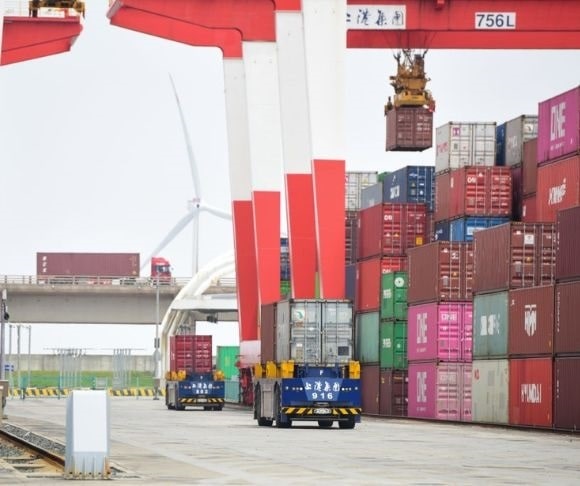
(Photo by Tian Yuhao/China News Service via Getty Images)
The United States is going through a cost-of-living crisis, driven by more than two years of astronomical fiscal and monetary expansion. But the country’s inflation woes are being exacerbated by China, the world’s second-largest economy that is shutting down large pockets of its nation in desperate attempts to eradicate the coronavirus. While this is a foolhardy endeavor by Xi Jinping and his merry band of communists, Beijing is manufacturing vast consequences for the United States and the rest of the global economy. It turns out that shutting down key economic hubs and transportation centers will exacerbate the worldwide supply chain crisis. Will this lead to companies fleeing the Red Dragon?
Playing a Game of Catch-Up
Over the last two months, China has been locking up millions of people in response to the outbreak of COVID-19 infections. The seven-day average is close to 30,000, a figure not even seen in the early days of the pandemic. The most notable lockdown occurred in Shanghai, a critical financial and port city. Public health authorities essentially shut down commerce, resulting in food shortages, factory closures, and people imprisoned at home.
With thousands of companies temporarily shuttering their doors, this created new supply chain snafus. Many orders were left unfilled, and shipments were delayed, producing immense backlogs and traffic volumes both in China and the western United States. But then another issue developed when the Chinese government listed 666 companies that were allowed to restart operations because they were considered necessary for producing priority goods. Businesses had to jump-start their factories and play catch-up quickly, so they have been accelerating production by having workers eat and sleep at these plants.
At the same time, two problems amplified. The first is that these entities do not possess enough components and parts to maintain output at the previous pre-lockdown rate. The second is that ramping up production is creating a bottleneck at the ports, making it more challenging for the ships to transport cargo.
Indeed, the numbers are eye-popping. Total congestion levels at Shanghai ports have skyrocketed as much as 40%, according to S&P Global Market Intelligence. The Outbound Tender Volume Index (OTVI) surged 6.6% over the last week. Freight-forwarder Flexport reported that the average number of days for Asian goods to reach the average US warehouse is 111.
What does this have to do with the US consumer price index (CPI) climbing to 8.5% in March?
China’s Problems, Americans’ Wallets
The United States imports approximately $540 billion per year from China, purchasing a wide range of goods, such as machinery, electronic equipment, nuclear reactors, apparel, and so much more. If the American marketplace does not get the goods on time – if ever – prices will inevitably adjust and respond, sending critical signals to the global landscape.

(Photo by Tian Yuhao/China News Service via Getty Images)
The International Monetary Fund (IMF) recently predicted that supply chain hiccups would add to inflation pressures this year, mainly because ocean shipping costs are a component of price inflation.
“Studying data from 143 countries over the past 30 years, we find that shipping costs are an important driver of inflation around the world: When freight rates double, inflation picks up by about 0.7 percentage point,” wrote the IMF study authors. “Most importantly, the effects are quite persistent, peaking after a year and lasting up to 18 months. This implies that the increase in shipping costs observed in 2021 could increase inflation by about 1.5 percentage points in 2022.”
And that’s how China’s lockdowns are creating a spillover effect into the rest of the world. If China coughs or sneezes, every other nation catches the latest strain of COVID. As long as the CCP maintains its COVID Zero strategy, the supply chain crisis, fueled by repeated lockdowns, will continue to add to inflation issues in the United States and elsewhere. Plus, this is in addition to soaring energy costs creating headaches for transportation networks and logistics chains.
One of the primary reasons Corporate America planted roots in China decades ago was cheap labor. However, with a strengthening yuan and the exceptional pain being felt from routine business disruptions, will insourcing, onshoring, or even a departure from China soon become a thing?
A Transitory Supply Chain Crisis?
Liberty Nation started ringing alarm bells early last year that a prolonged and severe supply chain crisis was on the horizon. By the time the problem landed on CNBC’s chyron, industry observers stated that these setbacks would be temporary and ease after Christmas. Well, it has been several months since Santa Claus stuffed our stockings with coal, and it is getting harder to see light at the end of the tunnel, mainly because a sea of cargo ships is blocking every view. Moreover, without any new infrastructure in place, it will be challenging for companies to defend their operations in China when other markets are now mostly open for business. Until then, the COVID Zero initiative will be a specter hanging over every post-pandemic economy on the planet, threatening the world with higher prices.
Remember to check out the web’s best conservative news aggregator
Whatfinger.com — the #1 Alternative to the Drudge

